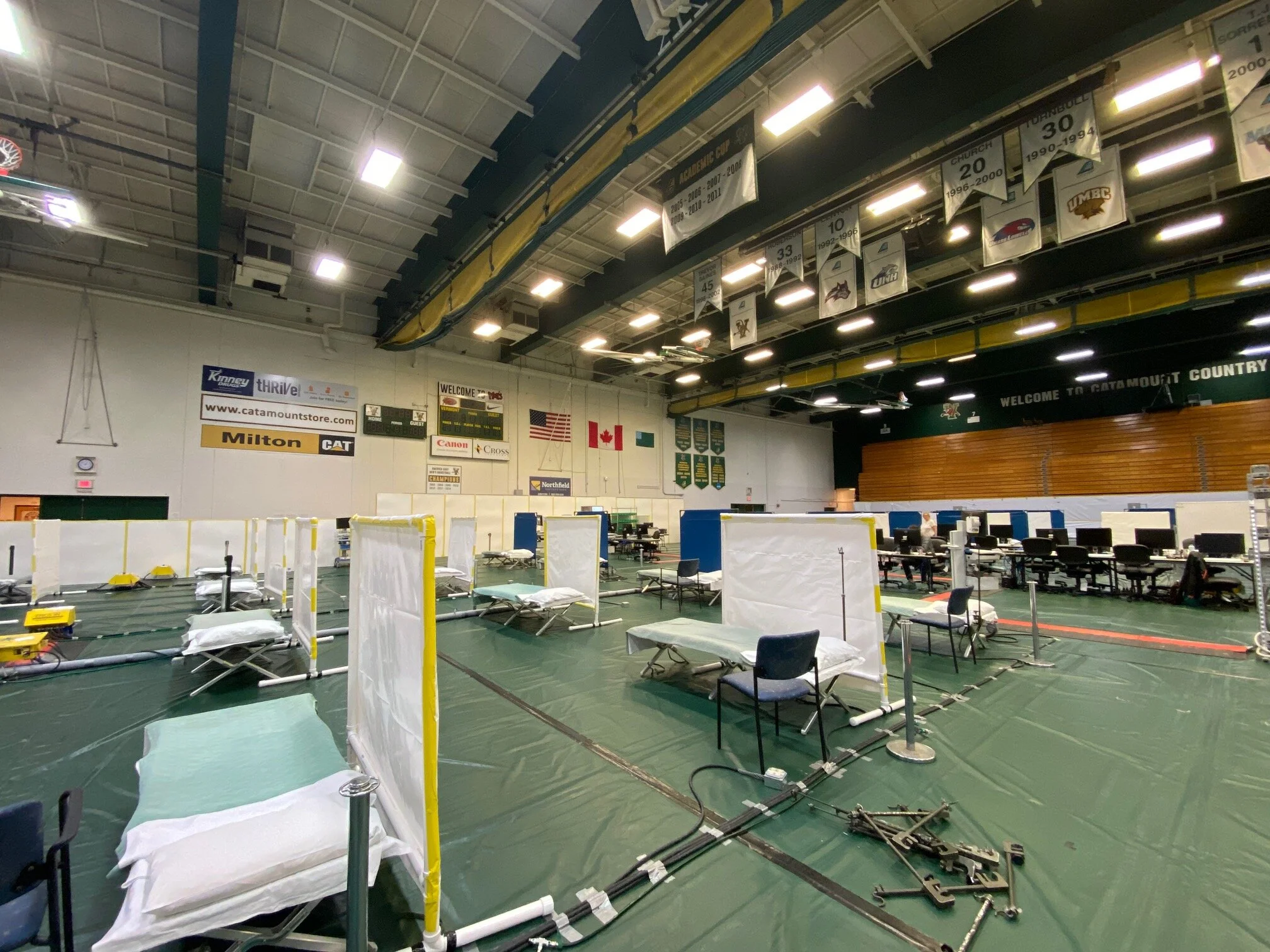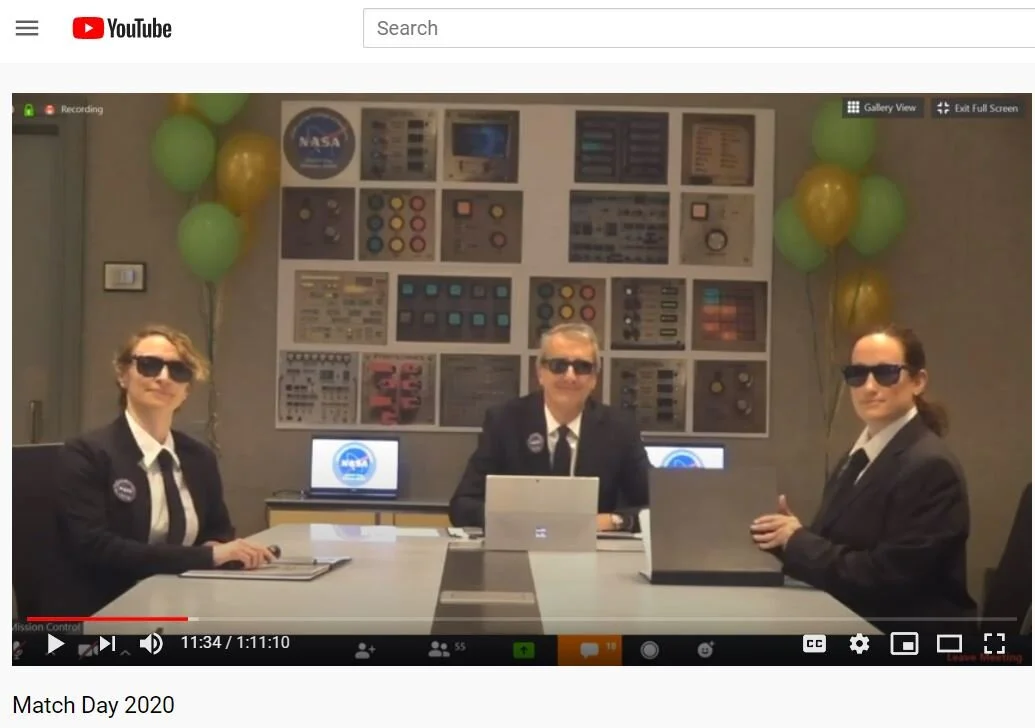BTV ground construction projects on schedule amidst COVID-19 disruptions
Although the onset of the COVID-19 virus to Vermont and the U.S. has greatly curtailed air travel and shrunk airport concession business, ground construction projects at Burlington International Airport so far remain on schedule for this spring.
For now, construction will continue on a taxiway realignment project and other improvements to tarmac areas near the airport’s terminal.
“We are taking it day by day,” said Nic Longo, the airport’s Deputy Director of Aviation.
Nic Longo, Deputy Director of Aviation at Burlington International Airport, stands on the site of the future terminal expansion. Photo by Gabriella Marchesi
The construction activity comes as Burlington International celebrates its centennial anniversary, a milestone immediately apparent upon passing through the main terminal’s sliding doors. Large mural-sized pictures cover the walls, depicting famous pilots and commissioners integral to the airport’s storied history.
One such pilot is George A. Gray, an original Wright flyer, whose pilot’s license was signed by Orville Wright himself. Gray was the first pilot to fly across Lake Champlain from Plattsburgh, N.Y. His half-scale model plane is hanging in the terminal lobby, as part of the centennial exhibition that includes reproduced wall-sized photographs of famous pilots including Amelia Earhart, whose 1934 stop remains a highlight of Burlington’s aviation history.
But while the airport honors its past, it remains focused on building for the future.
In 2019, the airport began construction on its taxiway realignment project, its air carrier apron project, along with a quick-turnaround facility for car rental companies to maintain their fleet.
In 2020, the airport aims to finish these projects. Plans were also on track to break ground on a new 110-room hotel located on the north end of the parking garage. The hotel start may be pushed back, however, given the current economic disruption due to the downturn in air travel connected with the COVID-19 virus pandemic.
Taxiway Realignment Project
In 2019, the FAA awarded Burlington International approximately $17 million for the Taxiway Realignment project – the largest grant in the airport’s history. Phase 1 of the project began last spring and Phase 2 began March 16, according to Longo.
The goal is to rebuild the taxiway to better connect the apron area -- the paved space where aircraft are parked, loaded, refueled, etc. -- to the taxiways that connect with the runways.
“Realigning the taxiway is really important for us,” Longo said. “It will help facilitate safer, faster and more efficient service.”
The taxiway that will soon be better connected to the runway Photo by Gabriella Marchesi
Right now, the main taxiway is not lined up parallel to the runway. The taxiway’s path currently contains a somewhat sharp turn in the pavement, Longo explained.
The project will entail moving the taxiway 100 feet closer to the runway. This will relocate the taxiway 100 feet further away from Airport Drive and the nearby neighborhood. Longo called that aspect positive because it may help reduce noise from the airfield. The pavement from the old taxiway will be torn up and replaced with grass, Longo said.
This project is huge both in terms of size and scale. It encompasses an area that stretches 1.5 miles. And it will impact air traffic control, the Vermont Air National Guard, and every airline that uses the airport in order for both construction to run smoothly and regular service not be disrupted.
Despite the recent impacts to air travel from the COVID-19 virus spread, airport officials mobilized the contract for construction on March 16. Longo said airport administrators, city staff, and all involved are working together to ensure that contractors adhere to guidelines put forth by the state.
“We are making sure that the contractors stay safe and adhere to social distancing policies,” Longo said. “But social distancing is also somewhat the nature of construction work, with each person operating their own machine.”
Airport Director of Aviation Gene Richards agreed that this project likely needs little alteration to proceed. “We can keep people safe and still working, so we are happy we are able to go ahead with this project as planned,” Richards said.
Air-Carrier Apron Project
For the past seven years, the airport has been working to rehabilitate aprons, or tarmac, areas. This entails digging up the concrete slabs that run 2.5 feet below the surface, then pouring and sealing new concrete. It’s vital to the upkeep of the airport, but can be disruptive to regular service.
“We work hard with all of the airlines to make sure that construction never interferes with regular service – something that is important to both them and us,” Longo said.
Main lobby inside the terminal at BTV, now adorned with “BTV 100” signs and murals marking the airport’s centennial. Photo by Gabriella Marchesi
This spring, construction will begin on the final phase of this work – the Gate 15 apron area used by JetBlue. In addition to regular concrete maintenance, some of the asphalt sections there will be replaced with concrete, Longo said
“This is the next step to growing the terminal apron,” Longo said. “We are expanding the apron for additional aircraft parking because of the growing service we are offering.”
The apron project is expected to begin April 15 and wrap up by the end of May.
But airport officials also understand that there are uncertainties given the coronavirus pandemic and workplace recommendations from public health officials and state government.
For example, staffing levels could be affected. “We are very cautious about making sure there will be enough people and staff to do the work and oversee the project as the weeks progress,” Longo explained.
Quick Turnaround Facility
After airlines, rental car service companies are a key business at the airport, accounting for $25 million a year in revenue, according to Longo.
Both Enterprise and Hertz operate in the quick turnaround facility, located just north of the parking garage on the right-hand side of Airport Road as you exit the airport. They use it to wash, fuel and maintain their vehicles.
The current facility is slated to be torn down in the coming months. The newly constructed facility – which is larger and can service more cars at once – is expected to be open in April, and will dramatically affect efficiency.
Despite all of the careful planning, Burlington International Airport’s centennial year so far has taken a turn that could make it one of its most financially difficult times.
But Richards said he is confident that the airport will be able to recover from these financial and operational setbacks.
“We will get through this, and may even be better because of it,” he said.
You can find this story in Vermont Business Magazine.









